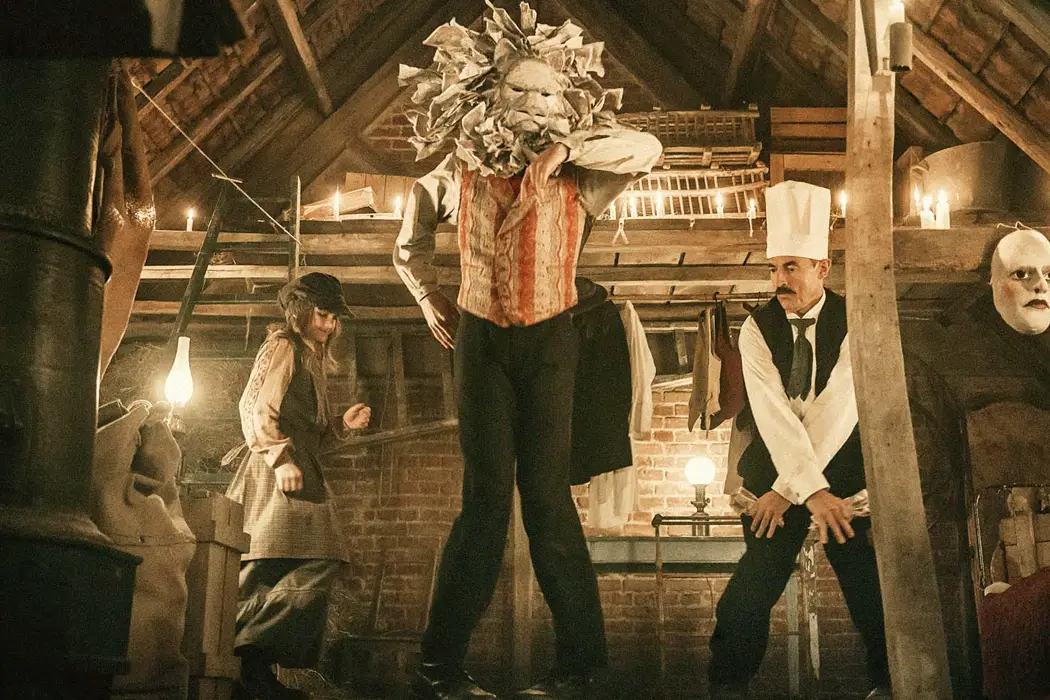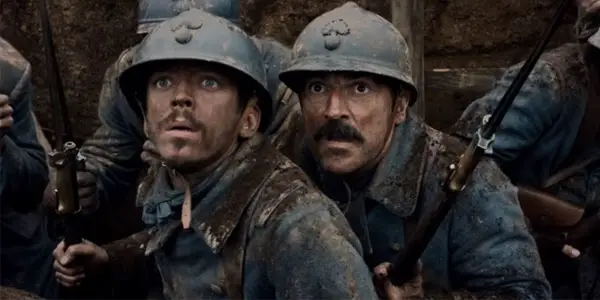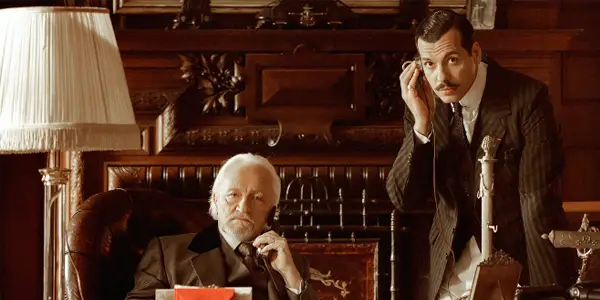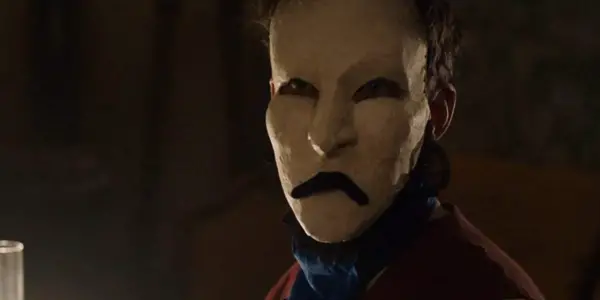SEE YOU UP THERE: Post-War Problems

Alex is a 28 year-old West Australian who has a…
As Ava Duvernay’s adaptation of A Wrinkle of Time is on the verge of arriving in cinemas, many have speculated about how the acclaimed director would go about reworking the alleged ‘unfilmable’ novel into an entertaining, accessible Disney feature film. There’s always a multitude of challenges for any director or writer who chooses to transform any favoured novel or literary source into a full-length movie, translating large portions of narrative, exposition and character development into balanced and captivating material.
Over in France, writer, director and lead actor Albert Dupontel has attempted just that, to convert the nearly 600-page beloved novel See You Up There (Au Revoir La-Haut) into a 2 hour comedic drama, an endeavour that has resulted in a dysfunctional but heavily unfocused adaptation.
The Catalyst for Chaos
Visualised as a multicoloured retread of Stanley Kubrick‘s Paths of Glory, the end of World War 1 has arrived, and in the midst of a distant battlefield, opposing members of the French and German armies sit at a standstill, both weary from their violent battles. Everyone is alleviated at the thought of the first World War finishing, except for the obsessed Captain Pradelle (a well cast Laurent Lafitte), who ignores the news and sends two unwilling soldiers towards the enemy.

When both are quickly killed, Pradelle leads his squad into one last battle, a rash decision that results in tragedy for soldiers Edourd Pericourt (Nahuel Perez Biscayart, the breakout start of BPM) and Albert Maillard (Albert Dupontel, who’s quite charming as the lead). Whilst saving Maillard from being buried alive, Pericourt unfortunately gets the bottom half of his face blown off by mortar fire, a horrible disfigurement that causes Maillard to become his close friend and guardian, especially during Pericourt’s lengthy recovery period.
After seeing his new face for the first time, Pericourt decides to fake his own death, switching identities with an orphaned dead soldier and hibernating himself in Maillard’s apartment whilst indulging in a crippling morphine addiction. Maillard slowly discovers the identity of his new friend, a sympathetic young artist whose passion for drawing was frequently rejected by his stoic, unforgiving banker father Marcel (Jacques Audiard’s go-to man Niels Arestrup).
This revelation forces Pericourt to restart his love for the arts, devoting his time to creating elaborate masks to hide his new facial wounds. As Pericourt’s family start to question the legitimacy of his supposed death, and the reappearance of the duplicitous Pradelle in their lives, Pericourt and Maillard decide to team up to kickstart an elaborate scheme, a risky undertaking which would score them enough cash to escape from their heartbreaking circumstances.
The pair’s plan is to have Pericourt design a catalogue of patriotic war memorials, in order to capitalize on the surge of post-war funerals that the end of World War 1 has caused. As Maillard tries to find the funds to print off the catalogues needed to start the scam, Pericourt decides to double-down on his conniving ways, creating another false alias in order to enter a statue-drawing contest that is being hosted by his father, a decision that might have more motivations than simply the big cash prize. These added plot elements slowly dilute each other, adding new convoluted story tangents that might cause casual audiences to lose track on what’s happening and why.
The Problems with Adaptations
In the story’s original literary medium, the intertwining lives of these 3 affected soldiers were given room to expand and space to properly flesh out their detailed backstories, but when condensed into a rapidly paced film format, their maturing journeys are compressed too much, which actively compromises the depth and level of care given to each of them. Dupontel tries to juggle the 3 different protagonists, alongside a growing ensemble of supporting players whose involvement further complicates the increasingly convoluted plot.

Even though Maillard is our narrator here (as he dispells the unfolding events to an unflappable policeman, Usual Suspects style), the grim odyssey of the disfigured Pericourt is easily the most interesting narrative strand, but he’s frequently pushed into the background, forgotten by the script for large periods of time. This also happens to Pradelle, who is introduced as quite a significant antagonist, only to make intermediate appearances when the story needs to introduce another contrived plot twist or an added touch of tension.
The Lack of Energy
This unbalanced characterisation extends into See You Up There’s overall style and narrative delivery, as Vincent Matthias’ cinematography and Christophe Pinel’s editing choices frequently transition from high-energy, manic pandemonium that feels reminiscent of French autuer Jean-Pierre Jeunet into lapses of competent, but bland moments of conventional conveyance.
With a story this bizarre and unpredictable, you’d think that See You Up There‘s behaviour would match this level of eccentricity, but much like Guy Ritchie’s King Arthur reboot last year, the final product feels like it’s made from two different directors whose work was spliced together: a distinctive artist who really heightens the absurdity of the situation, mixed in with the work of a traditional filmmaker whose simply approaching the script with a negligent attitude.

This is not to say that the movie’s aesthetics are ugly, as one of its strongest aspects is its creative production and costume designs, a colourful array of period clothing and unique masks, as Pericourt constantly switches masks based upon the situation and current mood. These designs, which range from the classic Greek comedy/tragedy masks to a beautifully detailed blue bird helmet, do a terrific job in adding to the personality of the mostly muted Pericourt, as well as being a constant source of much-needed humour. The lavish recreations of 1920’s Paris is impressive, with the most eye-catching sequence occurring in the grand estate of Pericourt’s wealthy father, whose housed himself within a mansion decked with a variety of red velvets, a nice visual juxtaposition to the barren, dusty apartment that his estranged son currently resides in.
See You Up There: Conclusion
Albert Dupontel’s ambitious adaptation of See You Up There is a conflicted production, an unconventional story told in quite a surprisingly ordinary manner. Despite some real imaginative sequences, which are illuminated by excellent production design and great costume choices, See You Up There‘s lacklustre style isn’t consistent, never quite reaching the heights that the absurd tale requires. It functions as a visual museum of French artistic eccentricity, but the short-changed characters and convoluted plotting constantly keeps the audience from truly engaging with this comedic post-war drama.
What are some of your favourite French films?
See You Up There will be playing at the Alliance Française French Film Festival 2018, which is touring Australia from Feb 27th – 8th April, screening times can be found here.
Does content like this matter to you?
Become a Member and support film journalism. Unlock access to all of Film Inquiry`s great articles. Join a community of like-minded readers who are passionate about cinema - get access to our private members Network, give back to independent filmmakers, and more.













